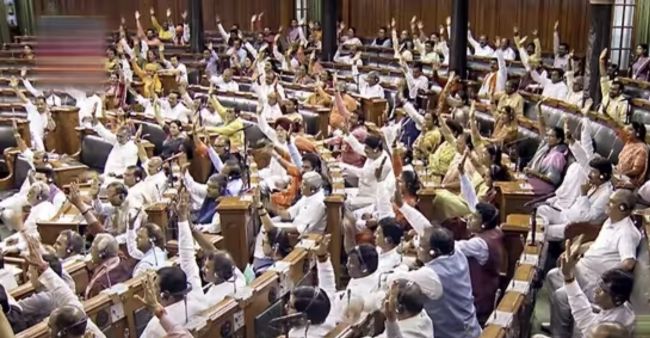The procedure for presenting a no-confidence motion is governed by Rules 198(1) to 198(5) of the Rules of Procedure and Conduct of Business in the Lok Sabha.
New Delhi
This week is going to be very stormy in the Indian Parliament. The no-confidence motion can be debated in the Lok Sabha this week. Congress member Gaurav Gogoi has moved a no-confidence motion in the Lok Sabha on behalf of the Opposition, which has been approved by the Speaker for debate. The House will have to discuss the proposal and then voting will also have to be done. Before voting, the Speaker will also decide how much time will be given to which party to speak in the debate on the no-confidence motion. Everyone knows the result of the voting. Despite this, the Opposition parties want to show Prime Minister Modi that even if they cannot force him to give a statement, but on the pretext of Manipur, the Prime Minister will have to give his statement in the House during the discussion.
In the current Lok Sabha, the ruling party BJP and its allies have 333 MPs, while the entire Opposition has only 142 MPs. The Opposition also knows that the no-confidence motion is bound to fail. Opposition parties want to call Prime Minister Modi in the House and get his statement on Manipur.
Under Article 75 of the Indian Constitution, the Union Council of Ministers, including the Prime Minister, is accountable to the Lok Sabha. The government can continue to function only as long as it maintains the majority support in the House. If a no-confidence motion is passed against the government, the Council of Ministers, including the Prime Minister, must resign.
The procedure for presenting a no-confidence motion is governed by Rules 198(1) to 198(5) of the Rules of Procedure and Conduct of Business in the Lok Sabha.
The process is as follows
n The member(s) of the Opposition party wishing to bring the no-confidence motion must seek permission from the Speaker of the Lok Sabha (Rule 198(1)(a)).
n A written notice of the motion has to be given to the Lok Sabha Secretary General by 10 am. If the notice is received after this time, it is treated as information received on the next day (Rule 198(1)(b)).
n At least 50 members must support the motion for it to be admitted by the Speaker (Rule 198(2)).
n Once permission is granted, the Speaker sets a date for the discussion on the motion (Rule 198(3)).
n On the last day of the discussion, a vote is taken, and the Speaker announces the decision (Rule 198(4)). The Speaker may also fix time limits for speeches during the discussion.
n If more than half of the members present in the House vote against the government in the no-confidence motion, the government falls.
It’s important to note that a no-confidence motion doesn’t need to be based on any specific reason, and the reasons mentioned in the notice are not considered part of the motion.
Regarding the legislative work in the Lok Sabha after a no-confidence motion is moved, there is no specific provision in the Indian Constitution that mandates the Speaker to stop legislative work. It depends on the discretion of the ruling party and the Lok Sabha whether to carry out legislative work during such a motion.
‘Indian Constitution does not prevent legislative business even if a no-confidence motion is brought’
No confidence motion can be brought in the Lok Sabha against the Government But this is the truth also that there is no any word like ‘no-confidence motion’ mention in the constitution of India. However, under Article 118, the House can frame its own procedure, while sub-rules 1 to 5 of Rule 198 provide that any member can give notice of a no-confidence motion against the government to the Speaker of the Lok Sabha. Similar Motion has been brought by Congress on 26th July. Let us know in detail what is no-confidence motion, how it is brought and how many times it was brought before July 26.
It is also important to know that when the motion of no confidence against the government has been brought in the Lok Sabha, then how the legislative work is going on in the Lok Sabha. In fact, there is no such provision in the Indian Constitution which directs the Speaker of the Lok Sabha to stop legislative work after a motion of no confidence is moved against the government. It is at the discretion of the ruling party and the Lok Sabha whether legislative work should be done in the Lok Sabha or not.

